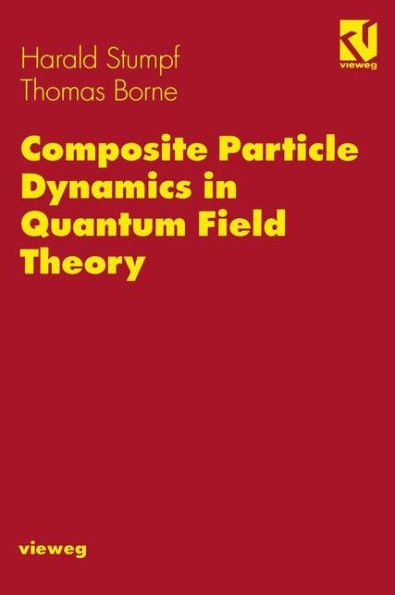5
1

Composite Particle Dynamics in Quantum Field Theory
274
by Harald Stumpf, Thomas Borne
Harald Stumpf

Composite Particle Dynamics in Quantum Field Theory
274
by Harald Stumpf, Thomas Borne
Harald Stumpf
Paperback(Softcover reprint of the original 1st ed. 1994)
$79.99
-
PICK UP IN STORECheck Availability at Nearby Stores
Available within 2 business hours
Related collections and offers
79.99
In Stock
Overview
Each atomistic theory of matter is based on the idea that agglomerations of their constituents are to be identified with observable objects of physical reality and that in this way the diversity of physical phenomena and reactions can be reduced to the interplay of a few elementary entities. This means theoretically that the formation of observable objects and their reactions have to be derived from the dynamics of their atomistic, i. e. elementary constituents. At present such atomistic theories of matter are formulated by quantum field theories. In view of the above described aim it is thus one of the most important tasks in quantum field theory to derive composite particles as bound states and to explain their dynamics as an effective dynamics induced by the elementary fields. In the development of quantum field theory many attempts have been made to solve this problem. So far, however, these attempts have been unsatisfactory and in this book some comments will be made on what the reasons are and where the difficulties arise. Roughly speaking the latter are closely connected with the idea to describe the effective dynamics of composite particles by means of the dynamics of field operator products. To avoid these difficulties we alternatively developed the method of weak mapping of quantum fields. The presentation of this method and of some applications to current problems is the object of this monography.

Product Details
| ISBN-13: | 9783528064983 |
|---|---|
| Publisher: | Vieweg+Teubner Verlag |
| Publication date: | 01/01/1994 |
| Edition description: | Softcover reprint of the original 1st ed. 1994 |
| Pages: | 274 |
| Product dimensions: | 5.98(w) x 9.02(h) x 0.02(d) |
| Language: | German |
Table of Contents
Notation.- 1 The Spinorfield Model.- 1.1 Introduction.- 1.2 Spinorfield Regularization.- 1.3 Lagrange Formalism.- 1.4 Canonical Spinorfield Quantization.- 1.5 Superindexing.- 1.6 Symmetry Conditions.- 2 Covariant Quantum Field Dynamics.- 2.1 Introduction.- 2.2 Construction of Functional States.- 2.3 Symmetries in Functional Space.- 2.4 Functional Field Equations.- 2.5 Nonperturbative Normalordering.- 2.6 Vertex Renormalization.- 2.7 Limits of Covariant Formalism.- 3 Algebraic Schrödinger Representation.- 3.1 Introduction.- 3.2 Indefinite State Spaces.- 3.3 Probability Interpretation.- 3.4 Nonorthogonal Basis Sets.- 3.5 Cyclic Basis Vector Representations.- 3.6 Renormalized Eigenvalue Equations.- 3.7 Functional Eigenvalue Equations.- 3.8 Normalordering.- 3.9 Covariant Equations on the Hyperplane.- 4 Weak Mapping Theorems.- 4.1 Introduction.- 4.2 Hard Core States.- 4.3 Selfconsistent Propagators.- 4.4 Effective Boson Dynamics.- 4.5 Direct and Exchange Forces.- 4.6 Estimate of Exchange Forces.- 4.7 Weak Mapping in Functional Space.- 4.8 Dressed Particle States.- 4.9 Effective Boson-and Composite Fermion-Dynamics.- 5 Bound State Calculations.- 5.1 Introduction.- 5.2 Covariant Bound State Equations.- 5.3 Vector Boson States.- 5.4 Four-Fermion Bound States.- 5.5 Dressed Fermion States.- 5.6 Metric of Dressed Fermion States.- 6 Effective Yang-Mills Dynamics.- 6.1 Introduction.- 6.2 Effective Boson-Fermion Dynamics.- 6.3 Boson States and Dual States.- 6.4 Evaluation of the Map.- 6.5 Quantum Properties of Mapped Fields.- 6.6 Effective Boson-Fermion Lagrangian.- 7 Fermions and Gravitation.- 7.1 Introduction.- 7.2 Anholonomic Spinor Connections.- 7.3 Weak Mapping with Gravitons.- 7.4 Graviton States.- 7.5 Dressed Fermion State Calculations.- 7.6 Fermion-Graviton Coupling.- 8 WeakMapping and Gauge Fields.- 8.1 Introduction.- 8.2 Spinor Electrodynamics in Coulomb Gauge.- 8.3 Quantization of Spinor Electrodynamics..- 8.4 Composite Particle Dynamics.- 8.5 Nonabelian Quantum Fields in Temporal Gauge.- 9 Superconductivity and Higgs Fields.- 9.1 Introduction.- 9.2 Selfconsistent Propagators and States.- 9.3 Spectrum of Bound States.- 9.4 Ginzburg-Landau Equation.- 9.5 Electrical Resistance.- 9.6 Thermostates and Weak Mapping.- 10 Path Integrals and Effective Theories.- 10.1 Introduction.- 10.2 Functional Perturbation Theory and Path Integrals.- 10.3 HadronizationofQCD.- 10.4 Composite Particles and Field Operator Products.- 10.5 Evaluation of Fermion Determinants.- 10.6 Conclusions.- 11 Fock Space Mappings.- 11.1 Introduction.- 11.2 Ideal and Physical Boson Spaces.- 11.3 Usui Mappings.- 11.4 Boson Mapping and Effective Dynamics.From the B&N Reads Blog
Page 1 of
